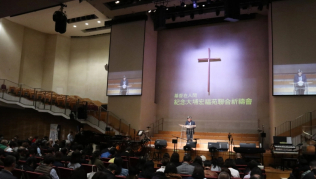World Vision’s The Hope Initiative is still ongoing as its third tour is waiting to be held in Dallas, April 26-30. The Hope Initiative is an exceptional campaign to address the needs of children, families and communities that have been devastated by the global HIV/AIDS crisis by mobilizing the Christian community and the general public. Through this campaign, World Vision is encouraging Americans to reach out their hands to the millions of orphans, widows and other vulnerable children affected by HIV/AIDS and to prevent the spread of HIV/AIDS.
This year, World Vision will go on tour in 25 cities across the nation. Scheduled tours include: Dallas (April 26-30), Denver (Sept. 6-10), Nashville, Atlanta, Bermuda, and Chicago. Its first tour already took place in Grand Rapids, MI, March 15, then Philadelphia and Los Angeles.
Christian Post interviewed current World Vision President Richard Stearns by e-mail. Richard Stearns became the president of World Vision U.S.A. in 1998. As president of World Vision U.S., Stearns is responsible for U.S. operations, which include fundraising, advocacy, and program development.
Founded in 1950,World Vision is an international Christian humanitarian organization serving the world's poorest children and families in nearly 100 countries.
Can you explain more about The Hope Initiative? -- regarding its history, when and how it began and where the conference is taking place this year.
World Vision launched the Hope Initiative December 1, 2000. Our AIDS work began, however, a decade before, working in Rakai, Uganda with children who had been orphaned by AIDS and the families who were trying to care for them. In 1990, World Vision also began working with AIDS-affected children in Romania, as well as efforts to keep girls from prostitution in Thailand.
In 2003, World Vision launched the Hope Tour, a campaign to bring increased awareness to Americans about the Global AIDS pandemic. World Vision is planning nine educational events this year featuring Christian musicians such as Third Day and Jars of Clay, and speakers like Rick and Kay Warren and Tony Campolo.
What are the goals World Vision is hoping to accomplish through this campaign?
The purpose of the Hope Tours is to create awareness about the global AIDS pandemic and to raise funds for the Hope Initiative. Last year we raised at least $1.2 million initially, and people touched by those events continue to give. Churches and individual Christians continue to get involved in the issue, including visits to Africa and advocacy with the Administration on Congress for full-funding of the President’s AIDS plan.
There are many other humanitarian Christian groups fighting against AIDS. Are there any other Christian groups participating in The Hope Initiative? How is the relationship of World Vision with other humanitarian Christian groups
The Hope Initiative is, specifically, a World Vision effort. However, in the countries where we work, World Vision partners with the local church and many other agencies – both Christian and secular – to bring help and relief to those who have been affected by the disease.
Can you explain about World Vision’s stance on President Bush’s $15 billion AIDS initiative? How do you think this proposal would affect World Vision’s outreach to vulnerable children and those who are already affected by AIDS?
As an organization, World Vision welcomes any funding that is to be used to help those affected by AIDS. We also are pleased that 10 percent of those funds have been designated for orphans and other children who have been made vulnerable by the disease. However, World Vision was disappointed to see that, in its first year, the initiative was not fully funded, nor does it appear that it will be fully funded during the next fiscal year. Initiatives like the President’s plan require the will of the Administration and Congress to enact and fund them.
Do you have any message you would like to convey in regards to what we can do as individual Christians and as a church to help relieve the HIV/AIDS crisis?
As the body of Christ, we must remember that one of our highest calls is to serve widows and orphans as well as those who are hungry, thirsty, sick, rejected and oppressed. AIDS creates all of these conditions – and offers us an opportunity to serve “the least of these.”
We should take the Good Samaritan as our example. In the parable, it didn’t matter if the man by the side of the road had been sinful, careless or innocently victimized. The Samaritan reached out to him regardless, funding his care and continuing to follow up on him to ensure his recovery. We are called to do the same.







